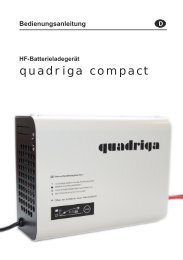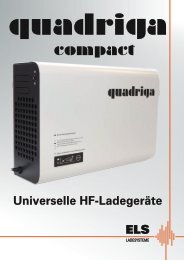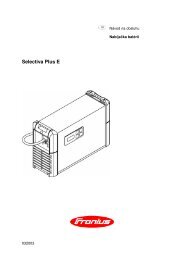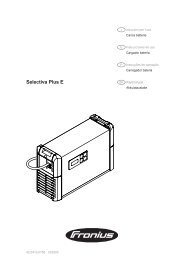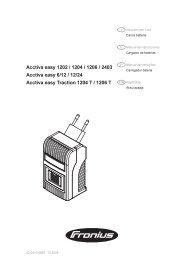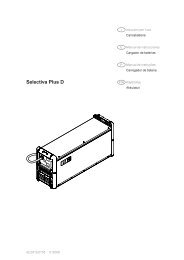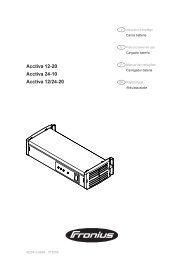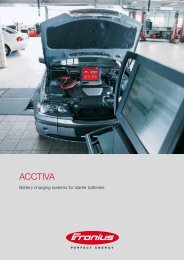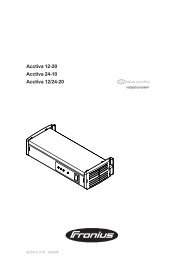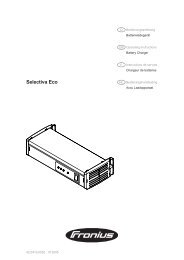Acctiva 12-8/10; 24-5; Classic; (Gel)
Acctiva 12-8/10; 24-5; Classic; (Gel)
Acctiva 12-8/10; 24-5; Classic; (Gel)
- No tags were found...
You also want an ePaper? Increase the reach of your titles
YUMPU automatically turns print PDFs into web optimized ePapers that Google loves.
<strong>Acctiva</strong> <strong>12</strong>-8<strong>Acctiva</strong> <strong>12</strong>-8 <strong>Gel</strong><strong>Acctiva</strong> <strong>12</strong>-<strong>10</strong><strong>Acctiva</strong> <strong>12</strong>-<strong>10</strong> <strong>Gel</strong><strong>Acctiva</strong> <strong>24</strong>-5<strong>Acctiva</strong> <strong>24</strong>-5 <strong>Gel</strong><strong>Acctiva</strong> <strong>Classic</strong><strong>Acctiva</strong> <strong>Classic</strong> <strong>Gel</strong>DGBFNLBedienungsanleitungBatterieladegerätOperating InstructionsBattery ChargerInstructions de serviceChargeur de batteriesBedieningshandleidingAccu Laadapparaat42,04<strong>10</strong>,0457 0<strong>12</strong>004
DEUTSCHSEHR GEEHRTER KUNDE!Die vorliegende Broschüre soll Sie mit der Bedienung Ihres Ladegerätesvertraut machen. Es liegt in Ihrem Interesse, die Bedienungsanleitungaufmerksam zu lesen und die hier angegebenenAnweisungen gewissenhaft zu befolgen. Sie vermeiden dadurchStörungen durch Bedienungsfehler. Das Gerät wird Ihnen diesdurch stete Einsatzbereitschaft und lange Lebensdauer lohnen.Vor Inbetriebnahme unbedingt das Kapitel „Sicherheitsvorschriften“lesen.BEDIENUNGSELEMENTENetzkabel / -SteckerLadeklemme „Plus“ - rotLadeklemme „Minus“ - schwarzAnzeige „Laden“Anzeige „Final-/Erhaltungsladen“Wahlschalter 3 / 8 A (nur <strong>Acctiva</strong> <strong>Classic</strong> u. <strong>Acctiva</strong> <strong>Classic</strong>GEL)Wahlschalter 6 / <strong>12</strong> V (nur <strong>Acctiva</strong> <strong>Classic</strong> u. <strong>Acctiva</strong> <strong>Classic</strong>GEL)Sicherungshalter u. SchmelzsicherungSicherungsdepotLeitungsdepotZur platzsparenden Unterbringung von Netz- und LadeleitungenVorrichtung für WandmontageZur Befestigung auf Hutschiene TS 35 (EN 50022)BATTERIE ANKLEMMENHinweis! Vor dem Anschluß der Ladeklemmen das Gerät vomNetz trennen. Achten Sie stets auf ordnungsgemäße elektrischeVerbindung der Ladeklemmen mit den Batteriepolen.- Ladeklemme mit dem Pluspol der Batterie verbinden- Ladeklemme mit dem Minuspol der Batterie - bei Kfz-Bordnetzen mit der Karosserie (z.B. Motorblock) - verbinden.BATTERIE ABKLEMMENUm die Verbindung des Ladegerätes zur Batterie bzw. zum Kfz-Bordnetz zu trennen befolgen Sie folgende Schritte:- Netzstecker des Ladegerätes ziehen- Ladeklemme des Ladegerätes entfernen- Ladeklemme des Ladegerätes entfernenBATTERIE LADEN1. Laden- Ladeklemmen wie zuvor beschrieben polrichtig anschließen- nur <strong>Acctiva</strong> <strong>Classic</strong> u. <strong>Acctiva</strong> <strong>Classic</strong> GEL: Wahlschalter undentsprechend der Batterietype in die richtige Stellung schaltenAchtung! Bei unsachgemäßem Gebrauch der Wahlschalterund ist der Hersteller für Sach- u. Personenschädennicht haftbar.- Netzstecker einstecken- Anzeige „Laden“ leuchtet - Batterie wird geladen- Anzeige „Laden“ wechselt auf „Final-/Erhaltungladen“Die Batterie ist zu 80 - 85 % geladen und somit betriebsbereit.Abb.1Batterieladegerät <strong>Acctiva</strong> <strong>Classic</strong>Text und Abbildungen entsprechen dem technischen Stand bei Drucklegung. Änderungen vorbehalten.3
2. Finalladen- Anzeige „Final-/Erhaltungsladen“ blinktBatterie noch weitere 6 Stunden am Ladegerät angeschlossenlassen um eine <strong>10</strong>0 %ige Ladung zu erreichen.3. Erhaltungsladen- Anzeige „Final-/Erhaltungsladen“ leuchtetDas Ladegerät schaltet nach dem Finalladen automatisch aufErhaltungsladen. Beim Erhaltungsladen wird der Selbstentladungder Batterie entgegengewirkt. Die Batterie ist ständigeinsatzbereit. Die Batterie kann beliebig lange am Ladegerätangeschlossen bleiben.Hinweis! Der parallele Betrieb von Verbrauchern (z.B. Autoradio,etc.) während des Ladevorganges ist möglich. Beachten Sie aber,daß sich die Ladezeit verlängert.STÜTZBETRIEBBeim Batteriewechsel versorgt das Ladegerät die Bordelektrik;elektrische Fahrzeugausstattungen (z.B. Fensterheber, etc.) könnenbetrieben werden. Um das Batterieladegerät im Stützbetriebzu betreiben sind folgende Vorkehrungen zu treffen:- Batterieladegerät vom Netz trennen- Motor abstellen, Zündung ausschalten- Standlicht einschalten (Grundlast)- Ladeklemmen und wie zuvor beschrieben polrichtig anden Polklemmen anklemmenAchtung! Der Stützbetrieb an einer <strong>12</strong> V Bordelektrik darfnie mit dem <strong>Acctiva</strong> <strong>24</strong>-5 bzw. an einer 6 V Bordelektrik mitdem <strong>Acctiva</strong> <strong>Classic</strong> in Schalterstellung <strong>12</strong> V durchgeführtwerden. Eine Zerstörung der Bordelektrik wäre die Folge.Bei unsachgemäßem Gebrauch ist der Hersteller für Sachu.Personenschäden nicht haftbar.Achtung! Bei unsachgemäßem Gebrauch der Wahlschalterund ist der Hersteller für Sach- u. Personenschädennicht haftbar.- Netzstecker einstecken- Anzeige Laden leuchtet- Polklemmen vorsichtig von der Batterie lösen - das Ladegerätübernimmt die Funktion der Batterie.- Batterietausch vornehmen- Polklemmen polrichtig mit der neuen Batterie verbinden- Netzstecker des Ladegerätes ziehen- Ladeklemmen und von den Polklemmen lösenSCHUTZEINRICHTUNGENSchutz vor Kurzschluß der LadeklemmenDurch einen elektronischen Kurzschlußschutz werden Schädendurch kurzgeschlossene Ladeklemmen verhindert. Ein Summtonsignalisiert den Kurzschluß der Ladeklemmen.Schutz vor thermischer Überlastung des LadegerätesSchutz vor Verpolen der LadeklemmenDie Schmelzsicherung verhindert Schäden bei Verpolung derLadeklemmen.Um nach einer Verpolung die Schmelzsicherung zu tauschengehen Sie wie nachfolgend beschrieben vor:- Ladegerät vom Netz trennen- Ladeklemmen von der Batterie abklemmen- Schraubkappe des Sicherungshalter entfernen- Schmelzsicherung tauschen<strong>Acctiva</strong> <strong>12</strong>-8, <strong>12</strong>-8 GEL, <strong>12</strong>-<strong>10</strong>, <strong>12</strong>-<strong>10</strong> GEL: Sicherung <strong>10</strong> A flink<strong>Acctiva</strong> <strong>24</strong>-5, <strong>24</strong>-5 GEL: Sicherung 6,3 A flink<strong>Acctiva</strong> <strong>Classic</strong>, <strong>Classic</strong> GEL: Sicherung <strong>10</strong> A flinkReservesicherungen befinden sich im Sicherungsdepot- nur <strong>Acctiva</strong> <strong>Classic</strong> u. <strong>Acctiva</strong> <strong>Classic</strong> GEL: Wahlschalter undentsprechend der Batterietype in die richtige Stellung schaltenBESCHREIBUNG DER ANZEIGENAnzeige Zustand BehebungAnzeige „Laden“ leuchtet Batterie wird geladen -Anzeige „Final-/Erhaltungsladen“blinktAnzeige „Final-/Erhaltungsladen“leuchtetAnzeigen leuchten nichtLadegerät „summt“Batterie wird finalgeladenLadeleitung defekt oder unterbrochenBatterie wird erhaltungsgeladen -Netzstecker nicht eingesteckt oder Netzkabeldefekt; Netz nicht vorhandenLadeklemmen verpolt angeschlossen -Schmelzsicherung hat ausgelöstKurzschluß der Ladeleitungen oder der Batterie-Ladeleitung überprüfen und FehlerbehebenNetzzuleitung überprüfenLadeklemmen polrichtig anklemmen undSchmelzsicherung erneuernLadeleitung und Batterie überprüfen undFehler beheben4
TECHNISCHE DATEN<strong>Acctiva</strong> <strong>Acctiva</strong> <strong>Acctiva</strong> <strong>Acctiva</strong> <strong>Acctiva</strong> <strong>Acctiva</strong> <strong>Acctiva</strong> <strong>Acctiva</strong><strong>12</strong>-8 <strong>12</strong>-8 GEL <strong>12</strong>-<strong>10</strong> <strong>12</strong>-<strong>10</strong> GEL <strong>24</strong>-5 <strong>24</strong>-5 GEL <strong>Classic</strong> <strong>Classic</strong> GELNetzspannung230 V~ 50 / 60 HzNennleistung <strong>10</strong>0 W <strong>10</strong>0 W <strong>12</strong>0 W <strong>12</strong>0 W <strong>12</strong>0 W <strong>12</strong>0 W <strong>10</strong>0 W <strong>10</strong>0 WLadespannung <strong>12</strong> V <strong>12</strong> V <strong>12</strong> V <strong>12</strong> V <strong>24</strong> V <strong>24</strong> V 6 / <strong>12</strong> V 6 / <strong>12</strong> VLadestrom 8 A 8 A <strong>10</strong> A <strong>10</strong> A 5 A 5 A 3 / 8 A 3 / 8 ANennkapazität Laden 36-180 Ah 36 - 180 Ah 36 - 180 Ah 36 - 180 Ah <strong>10</strong> - <strong>10</strong>0 Ah <strong>10</strong> - <strong>10</strong>0 Ah 2 - 180 Ah 2 - 180 Ahladbare Zellen 6 6 6 6 <strong>12</strong> <strong>12</strong> 3 / 6 3 / 6Einschaltdauer <strong>10</strong>0 % <strong>10</strong>0 % <strong>10</strong>0 % <strong>10</strong>0 % <strong>10</strong>0 % <strong>10</strong>0 % <strong>10</strong>0 % <strong>10</strong>0 %Ladekennlinie IWUoU IWUoU IWUoU IWUoU IWUoU IWUoU IWUoU IWUoUSchutzart IP 31 IP 31 IP 31 IP 31 IP 31 IP 31 IP 31 IP 31Gewicht 980 g 980 g 980 g 980 g 980 g 980 g 980 g 980 gAbmessungen (bxhxt)185 x 70 x 142 mmSICHERHEITSVORSCHRIFTENGefahren im Umgang mit dem LadegerätDas Ladegerät ist nach dem Stand der Technik und den anerkanntensicherheitstechnischen Regeln gebaut. Dennoch drohen beiFehlbedienung oder Mißbrauch Gefahr für- Leib und Leben des Bedieners oder Dritter,- das Ladegerät und andere Sachwerte des Betreibers.Alle Personen, die mit der Inbetriebnahme, Bedienung, Wartungund Instandhaltung des Ladegerätes zu tun haben, müssen- entsprechend qualifiziert sein,- Kenntnisse im Umgang mit Ladegeräten und Batterien habenund- diese Bedienungsanleitung genau beachten.Störungen, die die Sicherheit beeinträchtigen, sind zu vermeidenund gegebenenfalls umgehend zu beheben.Bestimmungsgemäße Verwendung: <strong>Acctiva</strong> <strong>12</strong>-8, <strong>Acctiva</strong> <strong>12</strong>-<strong>10</strong>, <strong>Acctiva</strong> <strong>24</strong>-5, <strong>Acctiva</strong> <strong>Classic</strong>- Das Ladegerät ist ausschließlich zum Laden von Akkumulatorenmit flüssigem Elektrolyt, sowie Vlies (AGM) und GEL Technologiein Starter- oder Traktionsanwendungen geeignet.- Das Laden von Trockenbatterien (Primärelementen) ist verboten.Bestimmungsgemäße Verwendung: <strong>Acctiva</strong> <strong>12</strong>-8 GEL, <strong>Acctiva</strong><strong>12</strong>-<strong>10</strong> GEL, <strong>Acctiva</strong> <strong>24</strong>-5 GEL , <strong>Acctiva</strong> <strong>Classic</strong> GEL- Das Ladegerät ist ausschließlich zum Laden von Akkumulatorenmit gelartigem Elektrolyt, sowie Vlies (AGM) Technologie inStandby-Anwendungen (z.B. Notstromanlagen) geeignet.- Das Laden von Trockenbatterien (Primärelementen) ist verboten.Verwenden Sie das Gerät nur- in liegender Position (siehe Abb.1),- wenn es vor direkter Sonnenbestrahlung und Nässeeinwirkunggeschützt ist und- die Kühlluft ungehindert durch die Luftschlitze strömen kann.Eine andere oder darüber hinausgehende Benutzung gilt als nichtbestimmungsgemäß. Für hieraus entstehende Schäden haftet derHersteller nicht.Veränderungen am Ladegerät- Ohne Genehmigung des Herstellers keine Veränderungen, EinoderUmbauten am Ladegerät vornehmen.- Teile in nicht einwandfreiem Zustand sofort austauschen lassen.Sicherheitsmaßnahmen im Betrieb- Ladegerät nur betreiben, wenn alle Schutzeinrichtungen vollfunktionsfähig sind.- Vor Einschalten des Ladegerätes sicherstellen, daß niemandgefährdet werden kann.- Vor Abklemmen der Ladeklemmen muß das Ladegerät vomNetz getrennt sein.- Mindestens einmal pro Woche das Ladegerät auf äußerlicherkennbare Schäden und Funktionsfähigkeit der Schutzeinrichtungenüberprüfen.Gefahren durch Netz- und Ladestrom- Ladeklemmen immer polrichtig anklemmen.- Ladekabel müssen fest, unbeschädigt und isoliert sein. LoseVerbindungen und angeschmorte Kabel sofort ersetzen.- Netz- u. Gerätezuleitung regelmäßig von einer Elektro-Fachkraftauf Funktionstüchtigkeit des Schutzleiters überprüfen lassen.- Vor Öffnen des Ladegerätes sicherstellen, daß dieses stromlosist. Bauteile die elektrische Ladung speichern entladen.- Das Gerät darf nur an eine Steckdose mit Schutzleiter (Erdung)angeschlossen werden. Als Zusatzschutz wird die FI-Schutzmaßnahmeempfohlen.- Netzspannung beachten! Die Angaben auf dem Typenschilddes Ladegerätes müssen mit den Daten des örtlichen Stromnetzesübereinstimmen.Gefahren durch Akkumulatoren- Batteriesäure ist ätzend und darf nicht in Augen, auf Haut oderKleidung kommen. Säurespritzer sofort und gründlich mit reinemWasser abspülen, notfalls einen Arzt aufsuchen.- Das während des Ladens entstehende Knallgas ist leicht entzündbar,Zündquellen (offenes Licht, brennende Zigaretten etc.)von der Batterie fernhalten. Unterlassen Sie auf Grund möglicherFunkenbildung auch das Abklemmen der Ladeklemmenwährend des Ladevorganges.5
- Der Ladevorgang darf nur in gut belüfteten oder dafür vorgesehenenRäumen durchgeführt werden.- Batterie vor Schmutz und mechanischer Beschädigung schützen.- Batterie laut Herstellerangaben warten.- Ausgangspunkt ist eine bis zur max. Markierung mit Säure(Elektrolyt) gefüllte Batterie.- Wöchentliche Sichtprüfung der Batterie durch den Anwender(gleicher Säurestand in allen Zellen).- Ungleichmäßiger Säurestand bzw. hoher Wasserverbrauch ineinzelnen Zellen kann durch einen Defekt in der Batterie hervorgerufenwerden.- Solche Batterien sind von einer Fachwerkstätte zu überprüfenund müssen gegebenenfalls ausgetauscht werden.- Während des Ladevorganges steigt der Säurespiegel der Batterie.- Aufgeladene Batterien in kühlen Räumen lagern. Bei ca. +2ºCbesteht die geringste Selbstentladung.Pflege, Wartung und Service- Gehäuseoberfläche des Ladegerätes regelmäßig mit lösungsmittelfreienProdukten reinigen.- Das Gerät ist wartungsfrei. Bei Funktionsstörungen wenden Siesich bitte mit dem Kaufbeleg / der Rechnung an Ihren Fachhändler.Garantie- und HaftungsansprücheDie Garantie- und Gewährleistungszeit für das Ladegerät beträgt2 Jahre ab Rechnungsdatum. Garantie- und Haftungsschäden beiPersonen- und Sachschäden sind jedoch ausgeschlossen, wennsie auf eine oder mehrere der folgenden Ursachen zurückzuführensind:- Nicht bestimmungsgemäße Verwendung des Ladegerätes- Unsachgemäßes Montieren und Bedienen- Betreiben des Ladegerätes bei defekten Schutzeinrichtungen- Nichtbeachten der Hinweise in der Bedienungsanleitung- Eigenmächtige Veränderungen am Ladegerät- Katastrophenfälle durch Fremdkörpereinwirkung und höhereGewaltDie CE-KennzeichnungDas Ladegerät erfüllt die grundlegenden Anforderungen der Niederspannungs-und Elektromagnetischen Verträglichkeits-Richtlinieund ist daher CE-gekennzeichnet.6
ENGLISHDEAR CUSTOMER,The subject brochure is intended to familiarise you with the operationof your battery charger. It is in your own interest to read thebrochure carefully and follow the instructions given exactly - so asto prevent malfunctions and operating errors. This will help toensure that your battery charger continues to give you constantservice for years to come. It is imperative that you read the section„Safety Regulations“ prior to using your battery charger.OPERATING ELEMENTSMains lead/plugCharging clip „Positive“ - redCharging clip „Negative“ - blackIndicator „Charge“Indicator „Final/Compensation Charge“Selector 3 / 8 A (only <strong>Acctiva</strong> <strong>Classic</strong> and <strong>Acctiva</strong> <strong>Classic</strong> GEL)Selector 6 / <strong>12</strong> V (only <strong>Acctiva</strong> <strong>Classic</strong> and <strong>Acctiva</strong> <strong>Classic</strong> GEL)Screw plug/fuseFuse depotCable winderTo store mains and charge cableWall mounting deviceTo mount charger on top hat rail TS 35 (EN 50022)CONNECTING BATTERYNote! Before connecting charging clips, interrupt power supply tocharger. However, be sure to connect each charging clip to thecorrect battery terminal.- Connect charging clip to the positive terminal of the battery- Connect charging clip to the negative terminal of thebattery - in case of motorcar supply systems to the body (e.g. themotor unit).DISCONNECTING BATTERYTo disconnect the battery charger from the battery or motorcarsupply system, proceed as follows:- Unplug charger mains plug- Remove battery charging clip- Remove battery charging clipCHARGING BATTERY1. Charge- Connect charging clips to the correct terminals as describedabove.- Only <strong>Acctiva</strong> <strong>Classic</strong> and <strong>Acctiva</strong> <strong>Classic</strong> GEL: turn selectorswitches and to correct position according to battery typeAttention! The manufacturer will accept no liability for anypersonal or material damage caused by an improper operationof selector switches and- Plug in mains plug- Indicator „Charge“ is illuminated - battery is being charged- Indicator „Charge“ shifts to „Final charge“The battery is 80 - 85 % full and therefore ready for use.Fig.1Battery Charger <strong>Acctiva</strong> <strong>Classic</strong>Text and illustrations correct at time of going to print. Right of alteration reserved.7
2. Final charge- Indicator „Final Charge“ flashes.To charge battery a <strong>10</strong>0 %, keep it connected to the charger foranother 6 hours.3. Compensation charge- Indicator „Compensation Charge“ is illuminatedAfter completing final charge, the battery charger automaticallyswitches to compensation charge to prevent battery from runningdown. The battery is constantly ready for use and may beconnected to the charger as long as you like.Note! It is possible to run appliances connected to the battery (e.g.car radio) during the charge. Please note that the charge will takemore time .SUPPORT OPERATIONWhile a battery is being replaced, the battery charger will supplythe electrical equipment with power so that it can be operated (e.g.window lift) meanwhile. To operate the battery charger in supportmode, take the following precautions:- Disconnect battery charger the power supply- Switch off motor, cut off ignition.- Turn on parking light (base load)- Connect charging clips and to the correct pole binders asdescribed above.Attention! Never operate in support mode an <strong>Acctiva</strong> <strong>24</strong>-5connected to <strong>12</strong> V vehicle equipment or <strong>Acctiva</strong> <strong>Classic</strong> withthe selector switch in <strong>12</strong> V position connected to 6 V vehicleequipment. This would cause a destruction of the electricalequipment. The manufacturer will accept no liability for anypersonal or material damage caused by an improper operationAttention! The manufacturer will accept no liability for anypersonal or material damage caused by an improper operationof selector switches and .- Plug in mains plug- Indicator „Charge“ is illuminated- Cautiously remove pole binders from battery terminals - thebattery charger takes over the function of the battery.- Replace battery- Connect pole binders to the correct terminals of the newbattery- Unplug mains cable of battery charger- Remove charging clips and from pole bindersPROTECTIVE GEARShort-circuit protection of charging clipsAn electronic short circuit protection precludes any damagescaused by a short circuit of the charging clips or charging lines.Such a short circuit is indicated by a buzzer tone.Protection against thermal overload of battery chargerProtection against reverse battery connectionFuse precludes damages caused by reverse connection. Proceedas follows to replace fuse following a reverse connection:- Disconnect charger from power supply- Disconnect charging clips from battery- Replace fuse<strong>Acctiva</strong> <strong>12</strong>-8, <strong>12</strong>-8 GEL, <strong>12</strong>-<strong>10</strong>, <strong>12</strong>-<strong>10</strong> GEL: fast-blow fuse <strong>10</strong> A<strong>Acctiva</strong> <strong>24</strong>-5, <strong>24</strong>-5 GEL: fast-blow fuse 6,3 A<strong>Acctiva</strong> <strong>Classic</strong>, <strong>Classic</strong> GEL: fast-blow fuse <strong>10</strong> AFuse depot contains spare batteries- only <strong>Acctiva</strong> <strong>Classic</strong> and <strong>Acctiva</strong> <strong>Classic</strong> GEL: turn selectorswitches and to correct position according to battery type.DESCRIPTION OF INDICATORSIndicator Condition EliminationIndicator „Charge“ is illuminated Battery is being charged -Indicator „Final/Compensation Charge“flashesIndicator „Final/Compensation Charge“litIndicators are not illuminatedBattery is being final-chargedCharging line defective or interruptedBattery is being compensation-charged -Mains plug not plugged in or mains linedamaged, no power supplyReverse connection of charging clips, fuseblown-Check charging line and repair failureCheck mains leadConnect squeezing inders correctly andreplace fuseCharger „buzzes“ Short-circuit of charging lines or battery Check mains lead and battery and repairfailure.8
TECHNICAL DATA<strong>Acctiva</strong> <strong>Acctiva</strong> <strong>Acctiva</strong> <strong>Acctiva</strong> <strong>Acctiva</strong> <strong>Acctiva</strong> <strong>Acctiva</strong> <strong>Acctiva</strong><strong>12</strong>-8 <strong>12</strong>-8 GEL <strong>12</strong>-<strong>10</strong> <strong>12</strong>-<strong>10</strong> GEL <strong>24</strong>-5 <strong>24</strong>-5 GEL <strong>Classic</strong> <strong>Classic</strong> GELSupply voltage230 V~ 50 / 60 HzNominal power <strong>10</strong>0 W <strong>10</strong>0 W <strong>12</strong>0 W <strong>12</strong>0 W <strong>12</strong>0 W <strong>12</strong>0 W <strong>10</strong>0 W <strong>10</strong>0 WCharging voltage <strong>12</strong> V <strong>12</strong> V <strong>12</strong> V <strong>12</strong> V <strong>24</strong> V <strong>24</strong> V 6 / <strong>12</strong> V 6 / <strong>12</strong> VCharging current 8 A 8 A <strong>10</strong> A <strong>10</strong> A 5 A 5 A 3 / 8 A 3 / 8 ANominal charging capacity 36-180 Ah 36 - 180 Ah 36 - 180 Ah 36 - 180 Ah <strong>10</strong> - <strong>10</strong>0 Ah <strong>10</strong> - <strong>10</strong>0 Ah 2 - 180 Ah 2 - 180 AhChargeable cells 6 6 6 6 <strong>12</strong> <strong>12</strong> 3 / 6 3 / 6Duty cycle <strong>10</strong>0 % <strong>10</strong>0 % <strong>10</strong>0 % <strong>10</strong>0 % <strong>10</strong>0 % <strong>10</strong>0 % <strong>10</strong>0 % <strong>10</strong>0 %Charging characteristic IWUoU IWUoU IWUoU IWUoU IWUoU IWUoU IWUoU IWUoUProtection category IP 31 IP 31 IP 31 IP 31 IP 31 IP 31 IP 31 IP 31Weight 980 g 980 g 980 g 980 g 980 g 980 g 980 g 980 gDimensions (wxhxd)185 x 70 x 142 mmSAFETY REGULATIONSDanger when handling the battery chargerThis machine has been constructed according to current technologyand complies with the currently applicable safety regulations.However, failure to observe the respective safety instructionsduring operation of the machine- may endanger the operator or third parties,- may adversely affect the machine or other property.All personnel entrusted with the start-up, operation, maintenanceand repair of the battery charger shall- be sufficiently instructed,- be acquainted with the handling of battery chargers and batteries- strictly observe these operating instructions.Avoid any malfunctions that might impair safety and, if necessary,eliminate them without delay.Intended use: <strong>Acctiva</strong> <strong>12</strong>-8, <strong>Acctiva</strong> <strong>12</strong>-<strong>10</strong>, <strong>Acctiva</strong> <strong>24</strong>-5, <strong>Acctiva</strong><strong>Classic</strong>- The charging unit is suitable exclusively for charging batterieswith liquid electrolyte, as well as glass fleece (AGM) and GELtechnology in starter or traction application.- The charge of dry batteries (primary cells) is prohibited.Intended use: <strong>Acctiva</strong> <strong>12</strong>-8 GEL, <strong>Acctiva</strong> <strong>12</strong>-<strong>10</strong> GEL, <strong>Acctiva</strong><strong>24</strong>-5 GEL, <strong>Acctiva</strong> <strong>Classic</strong> GEL- The charging unit is suitable exclusively for charging batterieswith gel electrolyte, as well as glass fleece (AGM) technology instandby applications (e.g. emergency power plants).- The charge of dry batteries (primary cells) is prohibited.When using this appliance, make sure that- it is in a horizontal position (see fig. 1),- it is protected from direct insolation and kept dry- vent holes are kept clear to allow cooling air to flow.Any other use shall not be in accordance with its intended use. Themanufacturer shall not be liable for any damage resulting fromsuch improper use.Modifications of the battery charger- Any modifications, supplements or reconstruction of the appliancemust not be carried out without the approval of themanufacturer.- Ensure parts in imperfect conditions are replaced immediately.9Safety precautions during operation- The battery charger may only be operated if all safety equipmentis in perfect working condition.- Before switching on the battery charger make sure that nopersons are jeopardized.- Before disconnecting the charging clips make sure that batterycharger is disconnected from the power supply .- Check battery charger at least once a week for externally visibledamage and deficiencies and make sure safety equipment is inproper working condition.Risks caused by mains and charging current- Always be sure to connect charging clips to correct terminals.- Make sure that the charging cables are fast, undamaged andinsulated. Loose connections or scorched cables must be replacedwithout delay.- Regularly entrust electrical engineering specialist with a PEcheck of the mains and appliance leads.Prior to opening the battery charger make sure it is currentless.Discharge charge-storing components.- This appliance may only be connected to plugs with a protectiveconductor (connection to ground). In addition, we recommend touse an overload protection.- Mind the supply voltage! The data mentioned on the rating plateof your battery charger has to be in accordance with thespecifications of your local electricity supply system.Risks caused by accumulators- Accumulator acid is caustic. Avoid any contact with the eyes, theskin or the clothes. Immediately flush acid splashes with clearwater and, if necessary, consult a doctor.- The electrolytic gas forming during the charge is highly inflammable.Keep ignition sources (naked light, lighted cigarette)away from the battery. Also refrain from disconnecting thecharging clips during the charge due to the risk of sparking.- The charge may only be performed in properly ventilated roomsthat are intended for this use.- Protect battery from dirt and mechanical damage.- Maintain battery to manufacturer‘s specifications.- Always start with battery filled with acid (electrolyte) to the max.marked level.- User to make a weekly visual check of battery (equal acid levelin all cells).
- Unequal acid level and/or high water consumption in the individualcells may be attributable to a battery defect.- In such cases, the battery must be checked in a specialistworkshop and, if necessary, it must be exchanged.- During the charge the acid level within the battery rises.- Store charged batteries in cool places. At a temperature ofapprox. +2ºC the running-down rate is lowest.Maintenance- Regularly clean casing surface using solvent-free agents.- This appliance is maintenance-free. In case of malfunctionscontact your supplier (purchasing document or invoice needed).Warranty and liability rightsThe guarantee and warranty period for the battery charger is 2years, from the invoice date.However, warranty and liability claims for injury or damage attributableto any of the following causes will not be accepted:- any other than the intended use of the battery charger- improper mounting or operation- operation of the battery charger with defective protection gear- non-observance of the operating instructions- modifications of the battery charger without approval by themanufacturer- foreign objects or an act of God.CE markingThis battery charger meets the essential requirements of the Low-Voltage and Electromagnetic Compatibility Directives and, therefore,is a CE-compliant product.<strong>10</strong>
FRANÇAISCHER CLIENT!Le but de cette brochure est de vous aider à vous familiariser avecla commande de votre chargeur. C’est dans votre intérêt de la lireattentivement et de respecter scrupuleusement les instructions ymentionnées. Ainsi vous contribuez à éviter des pannes dues àune fausse manœvre. L’appareil vous en récompensera par unedisponibilité permanente et une longue durée de vie. Avant la miseen service, il est obligatoire de lire le chapitre „Prescriptions desécurité“.ELEMENTS DE REGLAGECâble d’alimentation/ Fiche de contactClip „Positive“ - rougeClip „Négative“ - noirIndicateur „Charge“Indicateur „Charge finale/compensation“Sélecteur 3 / 8 A (seul <strong>Acctiva</strong> <strong>Classic</strong> et. <strong>Acctiva</strong> <strong>Classic</strong> GEL)Sélecteur 6 / <strong>12</strong> V (seul <strong>Acctiva</strong> <strong>Classic</strong> et <strong>Acctiva</strong> <strong>Classic</strong> GEL)Bouchon fusible et fusibleDépôt fusibleDépôt de câblePour y déposer les câbles d’alimentation et de chargeDispositif de fixage au murPour le fixage au profilé chapeau TS 35 (EN 50022)CONNECTER L’ACCUMULATEURNota! Il faut couper l’alimentation au chargeur avant de connecterles clips. Veuillez toujours connecter chaque clip au borne respectifde l'accumulateur.- Connecter clip au borne positif de l'accumulateur- Connecter clip au borne négatif de l'accumulateur ou bien- dans le cas de réseaux de bord de véhicules - à la carrosserie(p. ex. au bloc des cylindres)DECONNECTER L'ACCUMULATEURPour déconnecter le chargeur de l'accumulateur ou bien du réseaude bord d’un véhicule, veuillez procéder de la manière suivante:- Débrocher la fiche de contact du chargeur- Déconnecter clip- Déconnecter clipCHARGER L'ACCUMULATEUR1. Charge- Connecter clips au correctes bornes, comme décrit ci-dessus.- seuls <strong>Acctiva</strong> <strong>Classic</strong> et <strong>Acctiva</strong> <strong>Classic</strong> GEL: en fonction dutype d’accumulateur, tourner sélecteur et sur la positionréquiseAttention! Le constructeur décline toute responsabilitépour les dommages corporels et matériels qui résulteraientd’une fausse manoeuvre du sélecteur et .- Ficher la fiche de contact- Indicateur „Charge“ est allumé - la charge est effectuée- Indicateur „Charge“ s’éteint et indicateur „Charge finale“s’allume.Le niveau de charge est de 80 - 85 %. Ainsi, l'accumulateur estprêt pour l’usage.Fig.1 Chargeur d´accumulateurs <strong>Acctiva</strong> <strong>Classic</strong>Texte et illustrations correspondent à la date de mise sous impression. Modifications réservées.11
2. Charge finale- Indicateur „Charge finale/compensation“ est alluméPour atteindre un niveau de charge de <strong>10</strong>0 %, la charge del'accumulateur doit être continuée pendant 6 heures.3. Charge de compensation- Indicateur „Charge finale/ compensation“ est alluméUne fois terminée la charge finale, le chargeur se met automatiquementen charge de compensation pour prévenir àl’autodécharge de l'accumulateur. L'accumulateur est en toutmoment prêt pour l’usage et peut être connecté au chargeuraussi long que l’on veut.Nota! Il est bien possible d’alimenter des appareils raccordés àl'accumulateur (p. ex. autoradio) pendant la charge. Veuillez teniren compte, cependant, que dans ce cas-là le temps de charge seraplus long.SERVICE DE SUPPORTLorsqu’il faut échanger un accumulateur, le chargeur veille àalimenter les installations électriques de bord et du véhicule (p. ex.remonte-glace). Pour mettre le chargeur en service de support,procéder de la manière suivante:- Couper l’alimentation du chargeur- Arrêter le moteur, couper le contact- Allumer feu de stationnement (charge de base).- Connecter clips et au correctes bornes, comme décrit cidessusAttention! Ne jamais utiliser en service de support un<strong>Acctiva</strong> <strong>24</strong>-6 connecté à des installations électriques debord conçues pour <strong>12</strong> V ou bien un <strong>Acctiva</strong> <strong>Classic</strong> dont lesélecteur est positionné sur <strong>12</strong> V connecté à celles conçuespour 6 V. Telle action résulterait en une desctruction complètedes installations électriques. Le constructeurn’acceptera aucune responsabilité pour des dommagesmatériels ou personnels dus à un usage non convenable.Attention! Le constructeur n’acceptera aucune responsabilitépour des dommages matériels ou personnels dus à unusage non convenable du sélecteur et .- Ficher fiche de contact- Indicateur „charge“ s’allume- Déconnecter tout prudemment les pinces polaires de l'accumulateur- le chargeur prend la relève de l’accumulateur.- Connecter les pinces polaires aux correctes bornes du nouvelaccumulateur.- Débrocher la fiche de contact du chargeur- Déconnecter tout prudemment les clips et des bornespolairesDISPOSITIFS PROTECTEURSProtection contre le court-circuit des clipsUne protection électronique contre le court-circuit empêche desdégâts dus à un court-circuit des clips. Tel court-circuit des lignes/clips est indiqué par un signal sonore.Protection contra la surcharge thermique du chargeurProtection contre la connexion reverseLe fusible empêche des dégâts dus à une connexion reverse.Suite à une connexion reverse le fusible est à remplacer de lamanière suivante:- Couper l’alimentation du chargeur- Déconnecter clips de la batterie- Devisserbouchon fusible- Remplacer fusibles<strong>Acctiva</strong> <strong>12</strong>-8, <strong>12</strong>-8 GEL, <strong>12</strong>-<strong>10</strong>, <strong>12</strong>-<strong>10</strong> GEL: fusible <strong>10</strong> A, actioninstantanée<strong>Acctiva</strong> <strong>24</strong>-5, <strong>24</strong>-5 GEL: fusible 6,3 A faction instantanée<strong>Acctiva</strong> <strong>Classic</strong>, <strong>Classic</strong> GEL: fusible <strong>10</strong> A, action instantanéeLes fusibles en reserve se trouvent dans le dépôt de fusibles- seuls <strong>Acctiva</strong> <strong>Classic</strong> et <strong>Acctiva</strong> <strong>Classic</strong> GEL: en fonction del’accumulateur à remplacer tourner sélecteur et sur laposition respectiveDESCRIPTION DES INDICATEURSIndicateur Etat EliminationIndicateur „Charge“ est allumé Charge est en train -Indicateur „Charge finale/compensation“clignoteCharge finale est en trainLigne de charge défectueuse ou interrompue„Charge finale/compensation“ illuminé Charge de compensation est en train -Les indicateurs ne sont pas allumés.Chargeur émet un signal sonoreFiche de contact ne pas fichée ou câbled’alimentation défectueux; aucune alimentationConnexion reverse des clips - fusibleactionnéCourt-circuit des lignes de charge ou del’accumulateur<strong>12</strong>-Vérifier ligne de charge et eliminer défautVérifier câble d’alimentationConnecter pinces aux correctes borneset remplacer fusiblesVérifier ligne de charge et accumulateuret éliminer défaut.
DONNÉES TECHNIQUES<strong>Acctiva</strong> <strong>Acctiva</strong> <strong>Acctiva</strong> <strong>Acctiva</strong> <strong>Acctiva</strong> <strong>Acctiva</strong> <strong>Acctiva</strong> <strong>Acctiva</strong><strong>12</strong>-8 <strong>12</strong>-8 GEL <strong>12</strong>-<strong>10</strong> <strong>12</strong>-<strong>10</strong> GEL <strong>24</strong>-5 <strong>24</strong>-5 GEL <strong>Classic</strong> <strong>Classic</strong> GELBranchement sur le réseau230 V~ 50 / 60 HzDébit nominal <strong>10</strong>0 W <strong>10</strong>0 W <strong>12</strong>0 W <strong>12</strong>0 W <strong>12</strong>0 W <strong>12</strong>0 W <strong>10</strong>0 W <strong>10</strong>0 WVoltage de charge <strong>12</strong> V <strong>12</strong> V <strong>12</strong> V <strong>12</strong> V <strong>24</strong> V <strong>24</strong> V 6 / <strong>12</strong> V 6 / <strong>12</strong> VCourant de charge 8 A 8 A <strong>10</strong> A <strong>10</strong> A 5 A 5 A 3 / 8 A 3 / 8 ACapacité nominale de charge 36-180 Ah 36 - 180 Ah 36 - 180 Ah 36 - 180 Ah <strong>10</strong> - <strong>10</strong>0 Ah <strong>10</strong> - <strong>10</strong>0 Ah 2 - 180 Ah 2 - 180 AhEléments chargeables 6 6 6 6 <strong>12</strong> <strong>12</strong> 3 / 6 3 / 6Temps de fonctionnement <strong>10</strong>0 % <strong>10</strong>0 % <strong>10</strong>0 % <strong>10</strong>0 % <strong>10</strong>0 % <strong>10</strong>0 % <strong>10</strong>0 % <strong>10</strong>0 %Caractéristique de charge IWUoU IWUoU IWUoU IWUoU IWUoU IWUoU IWUoU IWUoUType de protection IP 31 IP 31 IP 31 IP 31 IP 31 IP 31 IP 31 IP 31Poids 980 g 980 g 980 g 980 g 980 g 980 g 980 g 980 gDimensions (lxhxp)185 x 70 x 142 mmPRESCRIPTIONS DE SECURITEDangers lors de la manœvre du chargeurLe chargeur a été construit selon les règles de l’art et les règles desécurité reconnues. Toutefois une fausse manœuvre ou bien unemploi abusif peut- constituer un risque de dommages corporels pour l’utilisateurou pour des tiers- produire des dégâts de la machine ou d’autre biens matériels.Des travaux comme mise en service, conduite, entretien et maintenancedu chargeur, ne doivent être réalisés que par du personnel- convenablement qualifié- expérimenté dans la manœvre de chargeurs et d’accumulateurs- observant scrupuleusement ces instructions de serviceEviter et notamment éliminer immédiatement tout malfonctionnementsusceptible de compromettre la sécurité.Utilisation conforme à l’emploi prévu: <strong>Acctiva</strong> <strong>12</strong>-8, <strong>Acctiva</strong><strong>12</strong>-<strong>10</strong>, <strong>Acctiva</strong> <strong>24</strong>-5, <strong>Acctiva</strong> <strong>Classic</strong>- Le chargeur est conçu exclusivement pour le chargementd’accumulateurs avec un électrolyte non-solide et la technologieVlies (AGM... Absorbed Glass Mat = mat de fibres de verresabsorbé) et GEL pour des opérations de démarrage ou detraction.- Il est interdit de charger des batteries sèches (piles primaires).Utilisation conforme à l’emploi prévu: <strong>Acctiva</strong> <strong>12</strong>-8 GEL, <strong>Acctiva</strong><strong>12</strong>-<strong>10</strong> GEL, <strong>Acctiva</strong> <strong>24</strong>-5 GEL , <strong>Acctiva</strong> <strong>Classic</strong> GEL- Le chargeur est conçu exclusivement pour le chargementd’accumulateurs avec un électrolyte gel et la technologie Vlies(AGM... Absorbed Glass Mat = mat de fibres de verres absorbé)pour les opérations de stand-by (par exemple les alimentationsélectriques de secours).- Il est interdit de charger des batteries sèches (piles primaires).Modifications du chargeur- Ne procéder à aucune mesure de transformation ou de montaged’éléments supplémentaires sans avoir l’autorisation du constructeur.- Remplacer immédiatement les éléments ne pas étant dans unétat parfaitConsignes de sécurité durant le service- Ne mettre le chargeur en service que lorsque tous les dispositifsde protection sont en état de fonctionnement.- Avant de mettre le chargeur en service, s’assurer que personnene peut être mis en danger.- Avant de déconnecter les clips, il faut couper l’alimentation duchargeur- Inspecter le chargeur au minimum une fois par semaine pourassurer qu’il n’y ait pas de dégâts visibles de l’extérieur et queles dispositifs de protection sont en état de fonctionnement.Dangers causés par le courant de ligne et de charge- Toujours connecter les clips au correcte borne- Les câbles de charge doivent être solides, intactes et isolés.Des défauts, tels que raccordements desserrés ou câbles carbonisés,doivent être éliminés immédiatement.- Les lignes de réseau et d’alimentation doivent être soumises àdes contrôles réguliers par un électricien compétent pour assurerque le conducteur de protection est en état de fonctionnement.- Avant de l’ouvrir, s’assurer que le chargeur est sans courant.Décharger les éléments accumulateurs de charge électrique.- Ne brancher cet appareil qu’à des prises de courant équipéesd’un conducteur de protection. Outre nous recommandons deveiller à ce qu’un déclencheur à maxima d’intensité soit prévu.- Ne brancher cet appareil qu’à un réseau conforme aux donnéesfigurant sur la plaque signalétique du chargeur.Ne mettre cet appareil en service que lorsque- il est en position horizontale (voir Fig.1),- il est protégé contre l’insolation directe et l’humidité- l’air de refroidissement peut passer librement par les canaux deventilationToute utilisation différente ou ultérieure est considerée de ne pasêtre conforme à l’emploi prévu. Le constructeur décline touteresponsabilité pour les dommages qui résulteraient d’une telleutilisation.13Risques liés aux accumulateurs- L’acide de batterie est caustique et ne doit pas entrer en contactavec les yeux, la peau ou les vêtements. Rincez immédiatementet abondamment les projections d’acide à l’eau claire, rendezvousle cas échéant chez un médecin.- Le gaz explosif qui se dégage durant la charge est facilementinflammable. Tenez toutes les sources d’inflammation (flammes,cigarettes allumées, etc.) éloignées de la batterie. N’enlevezpas non plus les pinces pendant la charge pour éviter touteformation d’étincelle éventuelle.
- Ne procédez à la charge que dans des locaux bien aérés ouprévus à cet effet.- Protégez la batterie de l’encrassement et de tout dommagemécanique.- Entretenez la batterie conformément aux indications du fabricant.- Sur une batterie neuve, l’acide (électrolyte) doit au départ arriverau niveau de la marque maximum.- L’utilisateur doit vérifier à l’oeil nu l’état de la batterie une fois parsemaine (même niveau d’acide dans toutes les cellules).- Une répartition inégale du niveau d’acide ou une consommationd’eau plus importante dans certaines cellules peuvent être duesà une défaillance de la batterie.- Vous devez dans ce cas faire contrôler les batteries défectueusespar un atelier spécialisé et les changer si nécessaire.- Le niveau d’acide de la batterie monte durant la charge.- Stockez les batteries chargées dans des locaux froids. C’est à+2º C environ que l’autodécharge est réduite au minimum.Entretien- Nettoyer à des intervalles réguliers la boîte à l’extérieur à l’aidede produits exempts de solvants.- L’appereil ne nécessite pas de maintien. En cas de fonctionnementdéfectueux, consulter le fournisseur (Il est nécessaire d’yprésenter la facture ou un document d’achat.)Droits á la garantieLe délai de garantie de l’ appareil s’éléve á 2 ans á dater de lafacture.Nous déclinons cependant toute responsabilité pour les dommagescorporels ou matériels dus á une ou plusierus des causessuivantes:- Utilisation qui n’est pas conforme à l’emploi prévu- Fausse manœuvre- Mise en service du chargeur lorsque les dispositifs protecteurssont défectueux- Inobservation des instructions de service- Modifications du chargeur sans l’autorisation du constructeur.- Dégât par un objet tiers ou bien force majeureSigne CELe chargeur satisfait aux exigences essentielles stipulés dans lesdirectives relatives à la basse tension et à la compatibilité électromagnétiqueet porte en conséquence le signe CE.14
NEDERLANDSGEACHTE KLANT!Deze brochure maakt u met de bediening van uw acculader vertrouwd.Het is in uw eigen belang de bedieningshandleiding zorgvuldigte lezen en de hier aangegeven instructies nauwgezet op tevolgen. U vermijdt hierdoor storingen door bedieningsfouten. Uwmoeite wordt door een permanente bedrijfsvaardigheid en eenlange levensduur van het apparaat beloond. Vóór de inbedrijfstellinga.u.b. in ieder geval het hoofdstuk „Veiligheidsvoorschriften“lezen.BEDIENINGSELEMENTENNetkabel / -stekkerLaadklem „plus“ - roodLaadklem „min“ - zwartIndicatie „Laden“Indicatie „Eind-/Instandhoudingsladen“Keuzeschakelaar 3 / 8 A (alleen <strong>Acctiva</strong> <strong>Classic</strong> en <strong>Acctiva</strong><strong>Classic</strong> GEL)Keuzeschakelaar 6 / <strong>12</strong> V (alleen <strong>Acctiva</strong> <strong>Classic</strong> en <strong>Acctiva</strong><strong>Classic</strong> GEL)Zekeringenhouder en smeltzekeringZekeringendepotLeidingdepotVoor een ruimtebesparend opbergen van net- en laadleidingenVoorziening voor wandmontageTer bevestiging op kaprail TS 35 (EN 50022)ACCU AANSLUITENAanwijzing! Vóór het aansluiten van de laadklemmen eerst hetapparaat van het net scheiden. Let steeds op een correcte elektrischeverbinding van de laadklemmen met de accupolen.- Laadklem met de pluspool van de accu verbinden- Laadklem met de minpool van de accu - bij auto-boordnettenmet de carrosserie (bijv. motorblok) - verbinden.VERBINDING MET ACCU VERBREKENOm de verbinding van de acculader met de accu resp. het autoboordnette scheiden gaat u als volgt te werk:- Netstekker van de acculader eruit trekken- Laadklem van de acculader verwijderen- Laadklem van de acculader verwijderenACCU LADEN1. Laden- Laadklemmen zoals bovenstaand beschreven op de juistepolen aansluiten- alleen <strong>Acctiva</strong> <strong>Classic</strong> en <strong>Acctiva</strong> <strong>Classic</strong> GEL: keuzeschakelaarsen in overeenstemming met het accutype in de juistestand schakelenOpgelet! Bij onvakkundig gebruik van de keuzeschakelaarsen is de fabrikant voor persoonlijk letsel en materiëleschade niet aansprakelijk.- Netstekker erin steken- Indicatie „Laden“ brandt - accu wordt geladen- Indicatie „Laden“ wisselt naar „Eind-/Instandhoudingsladen“De accu is voor 80 - 85 % geladen en dus bedrijfsklaar.Afb.1Acculader <strong>Acctiva</strong> <strong>Classic</strong>Tekst en afbeeldingen zijn bij het ter perse gaan technisch gezien op de laatste stand. Wijzigingen voorbehouden.15
TECHNISCHE GEGEVENS<strong>Acctiva</strong> <strong>Acctiva</strong> <strong>Acctiva</strong> <strong>Acctiva</strong> <strong>Acctiva</strong> <strong>Acctiva</strong> <strong>Acctiva</strong> <strong>Acctiva</strong><strong>12</strong>-8 <strong>12</strong>-8 GEL <strong>12</strong>-<strong>10</strong> <strong>12</strong>-<strong>10</strong> GEL <strong>24</strong>-5 <strong>24</strong>-5 GEL <strong>Classic</strong> <strong>Classic</strong> GELNetspanning230 V~ 50 / 60 HzNominaal vermogen <strong>10</strong>0 W <strong>10</strong>0 W <strong>12</strong>0 W <strong>12</strong>0 W <strong>12</strong>0 W <strong>12</strong>0 W <strong>10</strong>0 W <strong>10</strong>0 WLaadspanning <strong>12</strong> V <strong>12</strong> V <strong>12</strong> V <strong>12</strong> V <strong>24</strong> V <strong>24</strong> V 6 / <strong>12</strong> V 6 / <strong>12</strong> VLaadstroom 8 A 8 A <strong>10</strong> A <strong>10</strong> A 5 A 5 A 3 / 8 A 3 / 8 ANom.capaciteit laden 36-180 Ah 36-180 Ah 36-180 Ah 36-180 Ah <strong>10</strong>-<strong>10</strong>0 Ah <strong>10</strong>-<strong>10</strong>0 Ah 2-180 Ah 2-180 AhOplaadbare cellen 6 6 6 6 <strong>12</strong> <strong>12</strong> 3 / 6 3 / 6Inschakelduur <strong>10</strong>0 % <strong>10</strong>0 % <strong>10</strong>0 % <strong>10</strong>0 % <strong>10</strong>0 % <strong>10</strong>0 % <strong>10</strong>0 % <strong>10</strong>0 %Laadkromme IWUoU IWUoU IWUoU IWUoU IWUoU IWUoU IWUoU IWUoUVeiligheidsklasse IP 31 IP 31 IP 31 IP 31 IP 31 IP 31 IP 31 IP 31Gewicht 980 g 980 g 980 g 980 g 980 g 980 g 980 g 980 gAfmetingen(bxhxd)185 x 70 x 142 mmVEILIGHEIDSVOORSCHRIFTENGevaren bij de omgang met de acculaderDe acculader is volgens de meest recente techniek en de erkendeveiligheidstechnische voorschriften gebouwd. Desondanks dreigter bij een verkeerde bediening of bij misbruik gevaar voor- leven en goed van het bedienend personeel of van derden,- deacculader en andere materiële waarden van degebruikerAlle personen die met de inbedrijfstelling, bediening, het onderhouden de reparatie van de acculader te maken hebben moeten- dienovereenkomstig gekwalificeerd zijn,- kennis van de omgang met acculaders en accu’s hebben, en- deze bedieningshandleiding precies aanhouden.Storingen die een negatieve invloed op de veiligheid hebbenmoeten worden vermeden en, indien van toepassing, per ommegaandeworden verholpen.Gebruik volgens de voorschriften: <strong>Acctiva</strong> <strong>12</strong>-8, <strong>Acctiva</strong> <strong>12</strong>-<strong>10</strong>, <strong>Acctiva</strong> <strong>24</strong>-5, <strong>Acctiva</strong> <strong>Classic</strong>- De acculader is uitsluitend geschikt voor het laden van accumulatorenmet vloeibaar elektrolyt, evenals vlies (AGM) en GELtechnologie bij starter- of tractietoepassing.- Het opladen van droge accu’s (primaire elementen) is verboden.Gebruik volgens de voorschriften: <strong>Acctiva</strong> <strong>12</strong>-8 GEL, <strong>Acctiva</strong><strong>12</strong>-<strong>10</strong> GEL, <strong>Acctiva</strong> <strong>24</strong>-5 GEL, <strong>Acctiva</strong> <strong>Classic</strong> GEL- De acculader is uitsluitend geschikt voor het laden van accumulatorenmet gelachtig elektrolyt, evenals vlies (AGM) technologiein standby- toepassingen (bijv. noodstroomaggregaten).- Het opladen van droge accu’s (primaire elementen) is verboden.Gebruik het apparaat alleen- in liggende positie (zie afb.1),- als het tegen directe zonnestralen en vochtinwerking beschermdis, en- de koellucht onbelemmerd door de luchtspleten kan stromen.Een ander of verdergaand gebruik geldt als niet volgens devoorschriften. Voor schade die hieruit ontstaat is de fabrikant nietaan-sprakelijk.Veranderingen aan de acculader- Zonder toestemming van de fabrikant geen veranderingen, inofverbouwingen van de acculader uitvoeren.- Onderdelen in niet-foutloze toestand meteen laten vervangen.17Veiligheidsmaatregelen bij het bedrijf- Acculader alleen in gebruik nemen, als alle veiligheidsvoorzieningen goed functioneren.- Vóór het inschakelen van de acculader ervoor zorgen datniemand gevaar kan oplopen.- Vóór het losmaken van de laadklemmen moet de acculader vanhet net gescheiden zijn.- Minstens één keer per week de acculader op uiterlijkherkenbare schade en functionaliteit van de veiligheidsvoorzienigencontroleren.Gevaren door net- en laadstroom- Laadklemmen altijd op de juiste polen vastklemmen.- Laadkabels moeten vast, onbeschadigd en geïsoleerd zijn.Losse verbindingen en gesmeulde kabels meteen vervangen.- Net- en acculadertoevoerleiding regelmatig door een elektrotechnicusop functionaliteit van de beschermingsgeleider latencontroleren- Voor het openen van de acculader ervoor zorgen dat dezestroomloos is. Componenten die elektrische lading opslaaneerst ontladen.- Het apparaat mag alleen op een stopcontact met beschermingsgeleider(aarding) worden aangesloten. Als extra beschermingwordt de FI-veiligheidsmaatregel aangeraden.- Netspanning aanhouden! De gegevens op het typeplaatje vande acculader moeten met de gegevens van het plaatselijkestroomnet overeenstemmen.Gevaren door accumulatoren- Accuzuur is een sterk bijtende vloeistof en mag niet met ogen,huid of kleding in contact komen. Zuurspetters onmiddellijk engrondig met schoon water afspoelen, indien noodzakelijk, eenarts raadplegen.- Het knalgas dat tijdens het laden ontstaat is licht ontvlambaar.Ontstekingsbronnen (open vuur, brandende sigaretten etc.) uitde buurt van de accu houden. Laat in verband met mogelijkevonkvorming ook het afklemmen van de laadkabels tijden hetladen achterwege.- Het laden mag uitsluitend in goed geventileerde of hiervoorbestemde ruimten plaatsvinden.- Accu voor vuil en mechanische beschadiging beschermen;- Accu volgens de instructies van de fabrikant onderhouden;
- Uitgangspunt is een tot de maximale markering met zuur (elektrolyt)gevulde accu;- Wekelijkse zichtcontrole van de accu door de gebruiker (gelijkezuurstand in alle cellen);- Ongelijke zuurstand c.q. hoog waterverbruik in enkele cellen kandoor een defect in de accu worden veroorzaakt;- Zulke accu’s dienen door een vakkundige werkplaats te wordengecontroleerd en eventueel te worden omgeruild;- Tijdens het laden stijgt de zuurgraad van de accu.- <strong>Gel</strong>aden accu’s in koele ruimten opslaan. Bij ca. +2ºC ontstaatde geringste zelfontlading.Reiniging, onderhoud en service- Kastoppervlak van de acculader regelmatig met oplosmiddelvrijeproducten reinigen.- Het apparaat heeft geen onderhoud nodig. Raadpleeg bij functiestoringenuw vakhandelaar en breng a.u.b. uw kassabon /rekening mee.Garantie- en aansprakelijkheidDe garantietijd en waarborgingsperiode voor de acculader bedraagt2 jaar vanaf datum van de rekening. Garantie- en aansprakelijkheidseisenbij persoonlijk letsel en materiële schade zijnechter uitgesloten, wanneer het ongeluk resp. de schade aan éénof meerdere onderstaande oorzaken te wijten is:- gebruik van de acculader niet in overeenstemming met devoorschriften- onvakkundig monteren en bedienen- gebruik van de acculader bij defecte veiligheidsvoorzieningen- niet opvolgen van de aanwijzingen in de bedienings-handleiding- eigenmachtige veranderingen aan de acculader- catastrofes door inwerking van vreemde voorwerpenen overmachtHet CE-conformiteitsmerktekenDe acculader voldoet aan de fundamentele eisen van de laagspannings-en elektromagnetische compatibiliteits-richtlijn en is daaromvoorzien van het CE-conformiteitsmerkteken.18




